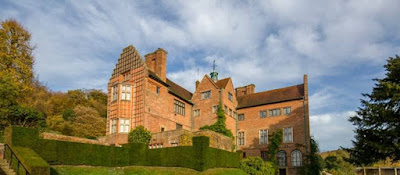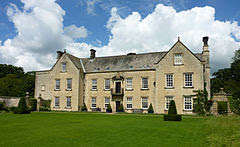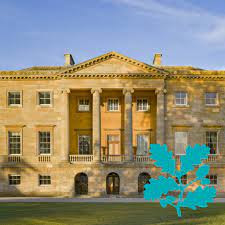 |
| National trust owned Mont acute House, Britain unsplash.com |
Since the unjust capture of Bengal province (believed to be the imperial “golden goose”) of the Indian subcontinent in the later part of the 18th century by Robert Clive and his cohorts of the EIC, hundreds of research paper and news paper articles had dealt with the subject of dishonest colonial expansion, the greed for land expansion, looting, exploitation of Indian resources and labor and how the vast Indian revenue helped England bring about the industrial revolution in that country. In 1750, India accounted for 25% of world economic production in contrast to England’s 1.9% . Bengal was at the center of that production.. Robert Clive said, “We have at last arrived at that critical period, which I have long foreseen; I mean the period which renders it necessary for us to determine whether we can, or shall, take the whole to ourselves.”
During the early English rule under the EIC, the proxy government under the dictates of the British Crown, the corrupt and oppressive company rule saw countless Britons becoming filthy rich after their long stint in the English company and how many of the pilferers were rewarded with a peerage by the crown administration, London. Living in a palatial villa back home with their retinue, their style of living was almost similar to affluent Maharajahs and Nawabs of India. But the nouveau riche English men with weird titles lacked just one thing; harem which almost every Indian ruler had; apparently an acceptable custom among the Indian monarchs.
A new revelation by UK’s National Trust has surprised the English people and those from the former British colonies. The National Trust never minced its words and told the media about the source of at least 50 valuable properties in England and Wales and their links with the East India Company, whose employees earned a bundle till 1857 in India and returned home and lived like Maharajah and Nawabs building large stylish houses with all kinds of embellishments. Some of their decedents followed suit and lived in splendor and style worthy of their special title.
 |
| Robert Clive's statue, Britain. hindustantimes.com |
The National trust owns and effectively manages large country houses, hundreds of historic houses, forts, castles and pastoral public spaces. Source of money: Without any hesitation and scruples the British Bobs looted the treasures from the fallen rulers' palaces, forts, etc., got hefty commission from the rich rulers and other royal members. In the early stages while running the trading operations in Bengal, the English company never paid the customs duty to the ruler for years. Apart, the administrators in collusion with their employees, on the side line, carried out mercantile trading activities without any permit from the ruler. This way many had multiple sources of income. Obviously, they were wallowing in money and had the audacity to carry on this unethical trading activities with their muscle and firing power.
The wealthy retired individuals fresh from India referred to as ‘White Nabobs had all the luxurious under the stars and sun and, obviously, had political clout and access to the royal court. There were many of them in the power corridor of the royal palace and found a niche in the Westminster Abbey in the 18th and 19th centuries.
The death of Floyd in the USA by the city cops of Minneapolis last year had created a public backlash against racism across the USA and Europe, especially, in the U.K, giving emphasis to "the Black Lives Matter" campaign. This initiated many governments and organizations to go down to the roots of ancestral properties of the rich and the National Trust has identified 93 properties that had links with colonialism, slavery and slave traders during the heyday of British Empire.
 |
| Naional Trust, England. en.wikipedia.org |
Above image: National Trust, UK: A charity and membership organization for heritage conservation in England, Wales and Northern Ireland. In Scotland, there is a separate and independent National Trust for Scotland. Founded in 1895 by Octavia Hill, Sir Robert Hunter and Hardwicke Rawnsley to "promote the permanent preservation for the benefit of the Nation of lands and tenements (including buildings) of beauty or historic interest". One of the largest landowners in Britain, it was given statutory powers, starting with the National Trust Act 1907.
 |
| Robert Clive, founder of British Empire. Alamy.com |
The said National Trust properties are popular tourist destinations in the UK with people in thousands daily making a beeline to them. Such time-honored places castles, forts, both archaeological and historical monuments, parks, etc., attract large people from all over the world. The 115-page report broadly focuses on the global slave trade and the compensation for slave ownership, as well as the English East India Company and the British Raj. Some of Britain’s most prominent and historic properties, including Chartwell in Kent, the family home of former Prime Minister Winston Churchill for over four decades, and Bateman’s, the residence of legendary novelist Rudyard Kipling from 1902 until his death, are part of the list. The frank and fair report by the trust evoked mixed reaction from the British public, from surprise to disappointment. Many members of the Trust were not happy with the bonafiide of the report and threatened to withdraw their membership and cancel their subscription.
 |
| Powis castle near Welsh pool, Wales, . ibritannica.com |
This frank public acknowledgement by the National Trust that their properties' financial sources came from the East India company operations in India and elsewhere, and to slavery and colonialism, is first of its kind and their bold revelation should be appreciated. Of the many properties, two of them have links with .Robert Clive, the first governor of Bengal presidency: his house in Claremont, Sussex, purchased from wealth he made in India and the Powis Castle in Wales, which has a large collection of Indian items. He started of his life in Chennai (Madras, Tamil Nadu as a clerk in the settlement of Ft. St. George.
 |
| Powis Castle, Wales interiorn.pinterest.com |
 |
| Siraj-ud-dualah's palqui, Bengal.bricklanecircle.org |
Above image: A palqi that once belonged to Siraj-ud-daula of Bengal which ended up here in this place. It was left by Siraj-ud- daula, when he fled the Battle of Plassey (BengaL) on 23 June 1757?. It became the property of Robert Clive.
 |
| Tipu Sultan's personal tent. artfund.org |
“At Claremont, purchased with the wealth he (Clive) had made in India, he built a new house, intended to be his main residence and to display the treasures he had amassed. In the early 1770s, Clive had begun acquiring Old Master pictures, which were intended for the Great Room at Claremont” according to Lucy Porten of the National Trust:“ At the time of his death, the house, unfinished and unfurnished, was a repository for his various collections, including that of ‘Indian Curiosities’ (still unpacked at that point). Robert’s son, Edward (1754–1839), would become 1st Earl of Powis, following his marriage to Lady Henrietta Herbert (1758–1830) in 1784, and Governor of Madras in 1798”.
 |
| Claremont House, England. victorianweb.org |
Above image: When the Duke of Newcastle died in 1768, his widow sold the estate to Robert Clive, founder of Britain's Indian Empire. Then just 50 years old, it was aesthetically and politically out of fashion. So, Lord Clive, now a fabulously rich British Nabob, wanted a big mansion with better design and impressive frontage matching his wealth looted from Bengal in the late 1700s. Old structure came down and it was replaced by a new one. Lancelot "Capability" Brown to build the present Palladian mansion on higher and dryer ground. Clive spent over £100,000 on rebuilding the house and a complete remodeling of the celebrated pleasure grounds. However, Clive never got a chance to adorn the richly appointed interior with his collection of Old Masters, Indian artefacts and other fine works, let alone test his new home’s marble plunge bath and other novel amenities. He committed suicide in 1774, the year of its completion The Battle of Plassey benefitted the Company and its officers in Bengal at the expense of the Indians. After the fall of ruler Siraj, Clive looted his treasury, leaving nothing for the new puppet ruler Mir Jafar, Clive’s ally. Clive took a jagir, an endowment of tax revenue for life, and, at the age of 33, became one of the richest men in England ..............
Their heterogeneous collections, totaling about 1,000 objects from about 1600 to the 1830s, are now on display at Powis Castle and include ivories, textiles, statues of Hindu gods, ornamental silver and gold, weapons and ceremonial amour from India and East Asia.”
 |
| Lord Curzon's Kedleton Hall. artuk.org/ |
Above image: The Kedleston properties, etc owned by Lord Cuirzon's descendents. George Nathaniel Curzon (1859–1925), who gave Bodiam and Tattershall Castles to the National Trust, had been Viceroy of India from 1889 to 1905. He was the main organizer of the Delhi Durbar (1903) and first man to start a Golf Course up on the hill of Naldehra, close to Shimla (Himachal Pradesh). It was one of the highest golf courses in the world, first one in India. Being a lover of Indian monuments, he brought an Eastern flavor to the house. An Indian museum remains, along with the fine sculpture and furniture, all of which Francis Curzon (1924–2000), 3rd Viscount Scarsdale, gave to the National Trust, with the assistance of the National Heritage Memorial Fund and the Art Fund, in 1987.Lord Curzon was an upright and efferent administrator and he never had a scandalous life in India. His favorite hill station was Shimla, the summer capital of British India.
Included in the list of India-related properties are: Lord Curzon’s Kedleston Hall in Derbyshire; former governor of Madras Ronald d’Arcy Fife’s Nunnington Hall in Yorkshire; the home of Francis Syke (one of the ‘nabobs’), Basildon Park, Berkshire; and Rudyard Kipling’s home Bateman’s in east Sussex.
The trust manages innumerable properties purchased at different periods covering a wide span of tine with ever changing political, cultural and social scenarios globally, but their research into their links with the slavery, colonialism, etc is part of their s commitment to correct historical narratives as they are classified in a broader sense. It will help us give proper information on the relevant properties and the historical facts they carry.
“A significant number of those in our care have links to the colonization of different parts of the world, and some to historic slavery. Colonialism and slavery were central to the national economy from the 17th to the 19th centuries”. according to the officials of NT. This post is based on the following articles.
 |
| Chirk Castle, in Wrexham, Wales.England indianexpress.com |
Above image: The 13th-century Chirk Castle in Wrexman, Wales was bought in the 16th century by Sir Thomas Myddelton I, a prominent sugar trader,. Myddleton and his brother, Robert, were one of the first investors in the East India Company in 1599. (Photo: National Trust)............................
 |
| Chartwell in Kent indianexpress.com |
Above image: Chartwell in Kent was former Prime Minister Winston Churchill’s family home for over four decades. Churchill served as the Secretary of State for the Colonies from February 1921 to October 1922. (Photo: National Trust)
 |
| Ronald d’Arcy Fife’s Nunnington Hall, N.Yorkshire. England. en.wikipedia.org |
 |
| Francis Syke's Basildon Park. England, facebook.com |
Tit-Bits:
 |
| Britain and slavery. scotsman.com |
 |
| Britain and slavery. ehsthelongrun.net |
Above image: From the cartoon ‘Slave Emancipation; Or, John Bull Gulled Out Of Twenty Millions’ by C.J. Grant. In Richard Pound (UCL, 1998), C.J. Grant’s ‘Political Drama’, a radical satirist rediscovered‘. Available at <https://www.ucl.ac.uk/lbs/project/logo.
 |
| .cartoonstock.com |
"Previously unseen documents reveal how Britain’s wealthiest families received millions of pounds in compensation after slavery was abolished in Britain’s colonies in 1833. Their descendants include Prime Minister David Cameron", the man who on his visit to Jallianwalla Bagh, Punjab. India a few years ago mumbled when he was asked about Britain not tendering apology to the Indian people for the atrocities committed during the colonial rule in India by the EIC and later by the Crown admiration.
According to a study conducted over a period of three years by Historian Dr Nick Draperas based on 46,000 records of compensation given to British slave-owners "as many as many as one-fifth of wealthy Victorian Britons derived their fortunes from the slave trade and the records show exactly who received what in payouts from the British Government when it was abolished – to the potential embarrassment of their descendants who still indirectly enjoy the proceeds. The British Government paid out £20 million to around 3,000 families for loss of their ‘property’ when slave-ownership was abolished. This represented a staggering 40% of the Treasury’s annual spending budget and equates to around £16.5 billion in today’s terms
By judiciously investing their slavery compensation money in banks that made them special offer - cash and credit, the planters who owned the slaves, could prolong and even expand their place in economies and societies built on the plantation system and the exploitation of black labor.
".https://www.abroadintheyard.com/19th-century-british-slaveowners-given-huge-payouts-after-abolition/
https://ehsthelongrun.net/2018/08/23/wages-of-sin-slavery-and-the-banks-1830-50/
http://webs.bcp.org/sites/vcleary/modernworldhistorytextbook/imperialism/section_4/robertclive.html







.webp)

